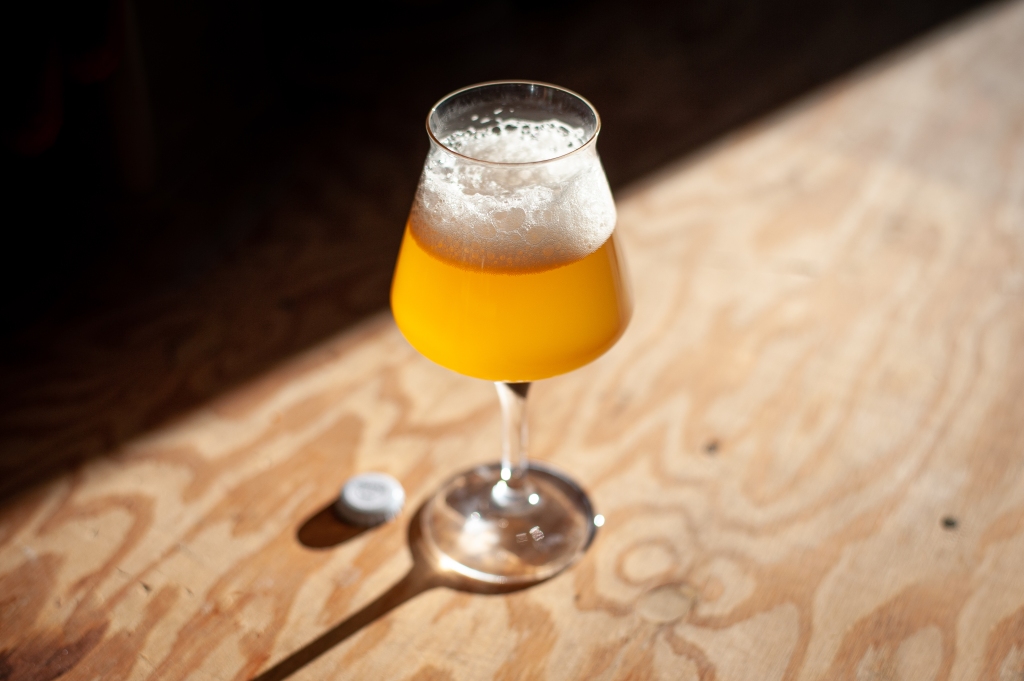Tasting: Saint Perpetua Barrel-Aged Solera Sour Ale + Dry-Hopped Version
I first wrote about my goal of creating a sour solera back in January of 2019, and since then the plan has unfolded in a series of careful steps. That first brew, fermented on my house culture and a variety of dregs from wild beers I enjoyed, lived in glass for a year before being bottled as Akhet. A portion of it was aged on lacto-fermented plums from my yard, to form Ume-Akhet.
These beers scored a 40 and a 38, respectively, in the 2020 KLCC BrewFest in Eugene, Oregon, and the former brought me my first gold medal as a homebrewer. Suffice it to say, I was really happy with how they came out.
But I wanted to up my solera game, so after I refilled the carboy and let the beer ferment out for another 6 months, I picked up a freshly dumped 15-gallon whiskey barrel from New Basin Distilling in Madras, OR. I decided not to rinse out the whiskey and simply added the second round of Akhet from the carboy, plus another 10 gallons of freshly made base wort fermented clean with Oslo kveik.
A little over a year after that—in December 2020, I bottled the first 4 gallons pulled from the barrel. Given the solera’s move from glass into a new wooden home, I decided it needed a new name, and thus Saint Perpetua was born.
I bottled those five gallons, neatly split between straight-up Saint Perpetua and a portion generously dry-hopped with Nelson Sauvin and Mosaic. After waiting through a (rare for me) Dry January, I cracked them open. Here’s what I found.
The Details
The vitals below are for the two batches of golden sour base that I added to the barrel on top of the portion that spent a year of mixed fermentation in the carboy.
The Vitals
- Method: BIAB
- Batch size: 6 gallons (x2)
- Mash: 90 minutes @ 154F
- Boil: 60 minutes
- Ferm temp: 90F
- OG: 1.048
- FG: 1.009
- FG (after barrel-aging): 1.001
- ABV: 6.2%
- IBU: 9
The Grain
- 7 lbs. Mecca Grade Estate Pelton (Pilsner)
- 2 lbs. Mecca Grade Rimrock (Rye Malt)
- 1 lb. Mecca Grade Shaniko (White Wheat Malt)
The Hops
- 25g Saaz [2.9% AA] @ 60 minutes
The Rest
- Yeast: Bootleg Biology Oslo Kveik (primary) + house mixed culture (secondary)
- Water: 7 gallons machine RO water + 1 tsp CaCl2 & 1 tsp gypsum
Saint Perpetua: How’s it taste?

A classic, very tasty barrel-aged golden sour, and a great start for my solera project.
Appearance: Crystal clear in the bottle, but with serious chill haze that turns it a translucent golden yellow (leaning orange) in the glass. Hazy, but not DDH NEIPA hazy. It’s highly carbonated, so there’s a lot of head to start with—loosely structured, with large bubbles that dissipate gradually until there’s just a thin ring around the edges of the glass. In short, it looks like most golden sour beers, but maybe a touch more opaque.
Aroma: Lots of barrel on the nose: oak that comes in the form of white wine, along with the slightest whiff of the whiskey that once lived in the barrel. Soft acidity, doughy malt, and mild alcohol follow. No hops detectable.
Taste: If old-school Cascade and de Garde sours are a 5 on the tartness scale, this is a 3. It’s assertively tart, but nowhere near acid reflux–inducing, enamel-stripping sour. You could easily drink a full bottle of this, in other words. (And I have! Several times!) The same white wine barrel character from the nose his the palate, along with the subtle impression of stone fruit—peaches and apricots, mostly. Soft, doughy malt character, with little noticeable THP. No alcohol or whiskey flavors are detectable in the flavor.
Mouthfeel: Prickly carb but more body than I expected from such a dry beer. Pillowy, almost, and a little syrupy. The flavor sticks around on your tongue for quite a while.
DH Saint Perpetua (Nelson + Mosaic): How’s it taste?

Easily my favorite of the two variants, this one is bursting with fresh hop flavor that melds surprisingly well with the base barrel-aged golden sour.
Appearance: Virtually identical to OG Saint Perpetua, but maaaaybe a touch hazier thanks to the dry hop.
Aroma: The smell just leaps out of the glass. I get lactic sourness and a strong fruitiness that initially smells like apricots or peaches and transitions over time into the bright berry character you can get from Mosaic. Riding along with the fruit character is a whiff of bright green lupulin and a soft undercurrent of oak. It’s seriously intoxicating. One of the best beers I’ve ever smelled. I just kept sticking my nose in the glass.
Taste: Tart, though less tart than the base version (maybe a 2 or 2.5 on the same scale), perhaps because the dry hops raised the final pH a little. It’s also intensely fruity—way moreso than the un-hopped Saint Perpetua. If someone just handed me this beer without any context, I swear after the first sip I’d assume there was fruit in it, and not just a little bit. It’s bonkers that it’s all coming from yeast and dry hops. After a few sips you can start to pick out the hops as hops—this has all the juiciness of a NEIPA but in a completely different context, and it works beautifully. As with the base beer, there’s a slight doughiness from the malt, but the chardonnay barrel character is more muted here, or at least outshone somewhat by the hops. Despite the up-front tartness, there’s a balancing sweetness from the malt that’s bolstered by the fruity hops. This is definitely a sour beer, but the hops have transformed it into something else entirely.
Mouthfeel: More or less identical to the base beer. The dry hops didn’t seem to make much difference here.
Plans for the Future

After refilling the barrel with fresh base beer, I tucked it back under my brew bench for another year-long nap. Next winter, I’ll pull another 5 gallons. What will I do with it? Probably another split batch, but this time I’m thinking I might add some fruit to one half—perhaps the 15 pounds of blackberries I’ve got hanging out in the freezer, or the 12 pounds of dark cherries. The other half? I dunno, I’d be crazy not to try this dry hopping thing again.
Regardless of which path I choose, I can’t wait to experiment with it year after year.
Culture-wise, I’m happy with the results here, but I’d love for there to be more Brett complexity vying for supremacy with the lactic acid bacteria, so I’m going to look for some choice Brett dregs to add to the barrel, and also brew future refills with an eye toward producing residual sugars and protein that the Brett can work on.

1 Comment